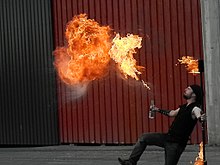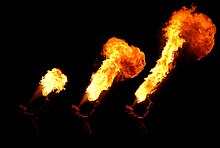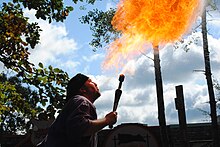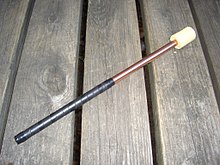| This article needs additional citations for verification. Please help improve this article by adding citations to reliable sources. Unsourced material may be challenged and removed. Find sources: "Fire breathing" circus act – news · newspapers · books · scholar · JSTOR (October 2014) (Learn how and when to remove this message) |










Fire breathing is the act of making a plume or stream of fire by creating a precise mist of fuel from the mouth over an open flame. Regardless of the precautions taken, it is always a dangerous activity, but the proper technique and the correct fuel reduces the risk of injury or death.
Performance
Fire breathing is performed by both professionals and non-professionals. Professional fire breathers usually incorporate the fire performance skill within a show where other fire skills are performed. The element of danger in performing fire breathing and other fire skills enhances the entertainment spectacle for many audience members.
Training
| This section does not cite any sources. Please help improve this section by adding citations to reliable sources. Unsourced material may be challenged and removed. (June 2015) (Learn how and when to remove this message) |
The vast majority of professional fire-breathers are apprenticed by a seasoned professional and it is strongly recommended that teaching oneself be avoided due to the extreme risks. Most people who are taught fire breathing and eating skills are seasoned performers in their own right and are taught under the condition that the skills not be passed on until they become a recognised fire performer. Virtually all recorded incidents of serious injury by fire breathing involve untrained individuals, often while under the influence of alcohol. Using an incorrect fuel is usually a strong contributing factor.
Health and safety
Performing with fire has many inherent risks to the health and safety of the practitioners. Fire breathing has a wider range of risks due to the required technique to create the effect. Having an actively spotting trained safety assistant with an appropriate fire blanket and fire extinguisher is an appropriate best practice when fire breathing and is a mandatory clause in most insurance policies for professional fire breathers.
Fuels
To increase safety, fire breathers must avoid highly combustible fuels such as alcohol, spirit-based fuels, and most petrochemicals, instead using safer combustibles with a higher flash point (>50 °C). Due to its relatively safe (≈90 °C) flash point, paraffin, or highly purified lamp oil, is the preferred fuel for fire breathing. Although corn starch has been cited as a non-toxic fuel, the hazards of inhalation increase the potential risk of lung infections.
Fuels that are considered especially dangerous include:
- Ethanol can be absorbed into the blood stream without drinking. Thus attempting fire breathing with ethanol can cause intoxication.
- Methanol (used with many colored flame recipes) has a variety of entry vectors and can cause blindness or neurological disorders.
- Very low flash point fuels like naphtha, butane, and propane can create a condensed vapor build-up in the oral cavity leading to internal combustion, damaging the mouth or lungs. Naphtha is also quite carcinogenic, and performance careers built on using it entail a high risk of mouth cancer.
- Common fuels like gasoline and kerosene often contain carcinogenic components, such as sulfurated compounds or benzene. They also are far easier to ignite and even a seasoned fire breather would be at serious risk of injury using these fuels for breathing
Self-ignition
There is a risk of self ignition while performing fire breathing. Enhanced risk comes from the use of lower flash point fuels, inappropriate fabrics in clothing (such as polyester), wearing other flammable items or products (such as hairspray), poor technique and performance in unsuitable locations.
Health
When fire breathing with the wrong fuel, or when an improper technique is used, fire breathing can increase the risk of:
- Death
- Severe burns
- Fire breather's pneumonia, a distinct type of lipid pneumonia
- Acute respiratory distress
- Oral and dental problems
- Fuel poisoning
- Dry cough
- Headache, dizziness, drunken ill feeling
- abdominal pains and diarrhea
- nausea and vomiting
- Dry tongue and cotton mouth
- Loss of taste
- Dry skin and topical heat burns
- Cancer of the mouth or throat from petrochemical exposure
History
A Roman slave named Eunus used fire breathing in an attempt to convince his fellow slaves that he had supernatural abilities in order for them to revolt against the Roman authorities. To do this, Eunus hid a nutshell containing burning material in his mouth.
In modern culture
Gene Simmons of the rock band Kiss often includes fire-breathing in the band's shows. "It's pretty dangerous," he observed. "If you don't blow it out and it doesn't explode the right way, it comes back at you. The tip is … don't. It's not worth it."
The MC Bat Commander, lead singer of the California comedy rock/New Wave/ska band The Aquabats, would regularly breathe fire to start off the band's shows during the late 1990s and early 2000s. Mike Odd, the vocalist for the shock rock/horror metal band Rosemary's Billygoat, included fire breathing in the band's many outlandish stunts, alongside other forms of small-scale pyrotechnics. Zoran Žikić, bass guitarist for the Serbian and Yugoslav hard rock band Kerber, used to perform fire breathing on stage. In 1984, during an open-air concert, he got second degree burns while trying to perform fire breathing under windy conditions. After this incident he was forbidden by the rest of the band members to continue performing the stunt.
World records
Simultaneous fire breathing
The world record for the number of people simultaneously fire breathing was set on 23 April 2009 by 293 students in the Dutch city of Maastricht as part of the Ragweek charity event.
Fire breathing pass
In August 2007 the record for the biggest fire breathing pass was set at the Burning Man festival in the Black Rock Desert, Nevada; a single breath was passed to 21 people before the flame went out.
Highest flame
The world record for the highest flame is 8.05 m (26 ft 5 in), set by Antonio Restivo at a warehouse in Las Vegas, Nevada, USA, on 11 January 2011.
Most flames
The most consecutive fire flames blown by one mouthful of fuel (without refuelling) is 387, achieved by Tobias Buschick (Germany) in Neuenbürg, Germany, on 1 August 2015.
The most flames blown in one minute is 189 (with refuelling) and was achieved by Zhu Jiangao (China) on the set of CCTV – Guinness World Records Special in Jiangyin, Jiangsu, China on 9 January 2015.
The most flames blown in 30 seconds is 55 (with refuelling) and is held by Christopher Campbell aka FenyxFyre (Canada) in London, Ontario, Canada, on 26 January 2021.
See also
References
| This article includes a list of general references, but it lacks sufficient corresponding inline citations. Please help to improve this article by introducing more precise citations. (April 2009) (Learn how and when to remove this message) |
- Pele "Fire Breathing", 2002. Retrieved 2010-10-18.
- NAFAA "NAFAA Performer Safety Guidelines. (Revision 2.1)", 2010-7-5. Retrieved 2010-10-18.
- I. Weinberg and Z. G. Fridlender "Exogenous lipoid pneumonia caused by paraffin in an amateur fire breather -- Weinburg and Fridlender 60 (3): 234", Occupational Medicine, 2010-3-22. Retrieved on 2010-8-22.
- Nickell, Joe (2005). Secrets of the sideshows. Lexington, Ky.: University Press of Kentucky. ISBN 0-8131-7179-2. OCLC 65377460.
- Collis, Clark (June–July 2004). "Dear Superstar". Blender. p. 58.
- "Aquabats and Mealticket to return for Ska Patrick's Day fest in Provo". Deseret News. 14 March 1997. Archived from the original on 23 October 2012.
- Distefano, Alex (21 November 2013). "Top 10 Shock Rock Bands of All Time". OC Weekly. Archived from the original on 31 March 2014. Retrieved 30 March 2014.
- Janjatović, Petar (2007). EX YU ROCK enciklopedija 1960–2006. Belgrade: self-released. p. 113.
- Stanojević, Vladan (2001). Enciklopedija niškog rock 'n' rolla 1962 – 2000. Niš: self-released. p. 74.
- "Most people fire breathing". guinnessworldrecords.com. Archived from the original on 19 August 2012. Retrieved 7 April 2011.
- "Fire breathing". Webster's online dictionary. Archived from the original on 16 April 2013. Retrieved 7 April 2011.
- "Highest flame blown by a fire breather". guinnessworldrecords.com. Archived from the original on 25 May 2012. Retrieved 7 April 2011.
- "Most consecutive fire flames blown by mouth without refuelling | Guinness World Records".
- "Most flames blown in one minute (fire breathing) | Guinness World Records".
- "Most flames blown in 30 seconds (fire breathing)". Guinness World Records. Retrieved 14 November 2022.
External links
- How to Blow Fire: 4 Steps – wikiHow
- North American Fire Arts Association Archived 19 August 2017 at the Wayback Machine
- Fire Breathing and Fire Eating FAQ by Juggling Information Service, 1996, retrieved 25 September 2006
- Fire Breathing Basics by